Samsung Fascinate Review: Verizon's Galaxy S Smartphone
by Brian Klug on October 5, 2010 12:01 AM EST- Posted in
- Smartphones
- Samsung
- Galaxy S
- Fascinate
- Mobile
Super AMOLED
Anand talked about the Galaxy S line's Super AMOLED display in his Epic 4G review. I thought I'd expand on that by saying that reducing the number of layers and air gaps between display, coating, capacitive digitizer, and finally top layer glass, is what the "Super" in Super AMOLED is all about.
It might not sound like a big deal, but reducing the number of interfaces between those light emitting OLED pixels and your eye is hugely important. Each successive interface - purely by being an interface with different index of refraction - creates a reflection that attenuates light. Glass to air interfaces usually have a reflection coefficient of around 4%, meaning only 96% of light makes it through. If you've got two or more air-glass interfaces, that adds up quickly, and you lose that light entirely to reflection. How much that reflection coefficient is depends on the index of materials at the interface, but more interfaces in general hurts transmission. Reflections and glare is also what makes reading displays difficult outside.
This sort of display-digitizer lamination is quickly becoming the norm rather than the exception. The iPhone 4 did it, and now Samsung is doing it with its own AMOLED displays - expect to see others do the same. The result is that there's perceptibly less distance between the top of the digitizer and the pixels themselves (viewed from an angle), and now less glare and more light making it through. Yay for optical contact!
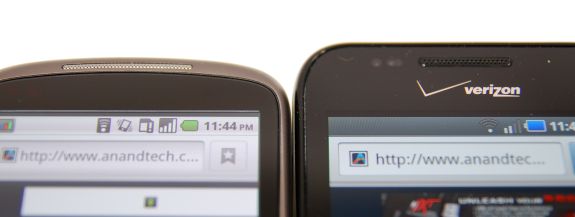
View this one bigger in full size to see what I mean
Next to the Nexus One, you can really see how much less distance there is between pixels and the surface of the top glass. The Samsung's Super AMOLED display literally appears to be on the surface.
The front of the Fascinate is one unbroken glass surface. Honestly, the display is probably the best part of the Fascinate. The 4" size isn't too big, but just right. At the bottom are capacitive buttons - as usual in yet a different order than I'm used to. Menu at the far left, home, back, then search from left to right.
The buttons are backlit, but only for a few seconds at a time. It's a bit frustrating, especially since right when you want them to be backlit most, they're inexplicably not lit.
I'd say AMOLED has come a long way since the Nexus One. My Nexus One routinely has ghosting and appears off-white - the Fascinate's Super AMOLED display is perfect. I used to be turned off by AMOLED's weird grain from the PenTile matrix - the Fascinate somehow has noticeably less. Either that, or I've just grown more accustomed to it. The oversaturation downside is still there, it's especially obvious when you pull screenshots from the Fascinate or any AMOLED device down to the desktop on a calibrated display.
Outside readability in practice is improved from the Nexus One. Honestly, it's still hard to read in direct sunlight outside, but it's better. For doing just about anything, seek shade.
Viewing angles on Super AMOLED are pretty awesome. I'd say contrast is pretty much unchanged even at extreme angles like 85 degrees. I've included lots of different angles and more outdoor and indoor comparison shots in the gallery below.
The oddest parts of the Fascinate's display are all the brightness settings. There are three of them - one in settings that every Android device has, another down below that's basically dynamic contrast, and one in the browser. It can get a bit confusing controlling everything that's going on brightness wise.
I measured a bit more brightness than Anand did on the Epic 4G:
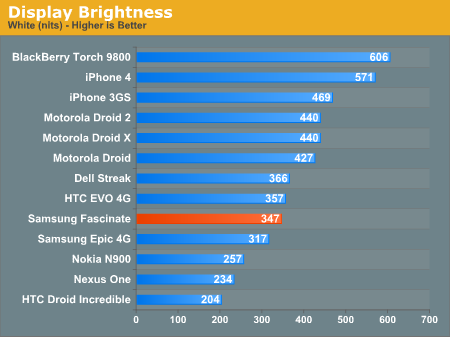

Black levels are perfect again, and thus so is contrast.
I have to agree with Anand - if resolution is what you care about, the iPhone 4 leads. If contrast and seriously vibrant (to the point of being oversaturated) colors are what you like, Super AMOLED is where it's at.


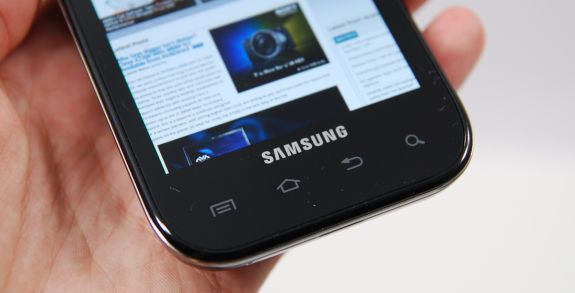
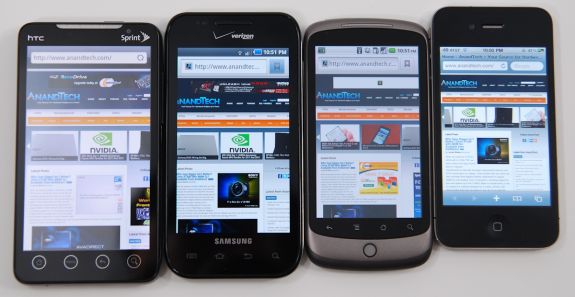
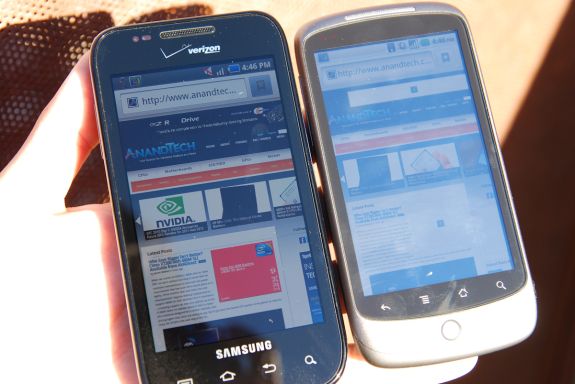














73 Comments
View All Comments
Brian Klug - Tuesday, October 5, 2010 - link
Chemist1,I actually completely agree with you, 100%. When I joined on to tackle smartphones, my big objective has and still is to nail down testing for everything that's traditionally been subjective - battery life, screen quality, performance, signal strength, e.t.c, and make it just as objective as hardware reviews. Of course, audio (voice) quality is on that list as well.
I've been grappling for some time on an ideal test methodology, one that would give a much better (objective) means of testing actual call quality than - it sounded good. I honestly couldn't agree more that this level of analysis is lacking. Unfortunately, until I've got that nailed down, it's really all I can say. What shape that takes is still up in the air.
I've thought of recording the local ASOS weather station test call (which is so far what I use for measuring speakerphone volume) through both the line-out and speaker, then letting people compare those audio files directly. I've considered using some spectral analysis tools similar to determine the pass bandwidth of these phones (of course this would require some tweaking due to cellular latency and also a land line), and a few other things. If you or other commenters have suggestions, I'm more than all ears, seriously ;)
I've actually done a fair amount of playing with CDMA voice codecs in the past - a number of WinMo devices would let you change from relatively-basic EVRC to better 13k voice codecs and a number of others. That kind of discussion and reporting about what codecs each device are using is where I'd like to go, getting that from Android sometimes is very difficult unfortunately. In fact, only device I've really seen that on so far is the EVO. I'd also like to eventually be able to characterize the difference between 1x voice, GSM and UMTS.
There's a lot more we're trying to add for certain, I/we just have to figure out what the best way of testing those would be.
-Brian
jasperjones - Tuesday, October 5, 2010 - link
You may find this shocking but I highly doubt people will consider audio quality as important as you do when deciding for a smartphone.I faintly remember some study on what consumers are looking for in portable audio/MP3 players. Audio quality was NOT in people's top 5! Design, storage capacity, and three other things I cannot recall right now were more important to them. In an audio device!!
So there you go.
chemist1 - Tuesday, October 5, 2010 - link
jasperjones: Thanks for your comment. Well, one needs to be careful of these surveys, since small differences in wording can significantly change the outcome. But your point is well-taken: audio quality is not a top priority for consumers. Nevertheless, that's not to say that audio quality is of no interest to the majority of consumers, nor that it should not therefore be of significant interest to us. [Please see paragraphs 2 and 3 of my reply to kmmanety.]MacTheSpoon - Wednesday, October 6, 2010 - link
Audio quality matters to me, too, thanks for fighting the good fight, chemist1. ;)By the way, I own the phone and I have found the audio to be pretty good for calls so far. At least, I haven't found myself wishing the phone was louder or had any problems distinguishing speech.
Listening to music with headphones...I don't have golden ears, and I don't know how it stacks up to a top mp3 player like a Cowon, but it's definitely not a low-end sound like my iPod Nano 4th Gen or my 2007 Macbook Pro, anyway.
strikeback03 - Thursday, October 7, 2010 - link
Kinda like how in CNET reviews of point and shoot cameras image quality only accounts for something like 10% of their final score.Though a lot of consumers probably just assume audio quality is good enough. The majority are going to put compressed music on there anyway and then use cheap earbuds, so a lot of the audio quality discussion that goes on on tech sites is utterly irrelevant to the majority.
cwebersd - Wednesday, October 6, 2010 - link
In addition to measurements of sound quality, how about a simple internal poll? Record sound samples of various phones, post them with obfuscated names for other staff members to listen to and have them judge intelligibility, clarity, harshness, etc. This should give you a decent sampling of real people's observations. Better than just your own.dagamer34 - Tuesday, October 5, 2010 - link
Brian, there are some JPEG artifacts in your gallery shots. I doubt the D80 has such visible artifacts on a downrezzed shot.Brian Klug - Tuesday, October 5, 2010 - link
Yeah unfortunately the gallery preview images are compressed even though I upload originals from all the cameras. If you click "View original size" you'll get the raw untampered JPEG though, complete with all the EXIF headers and everything you'd get from the camera. Unfortunately I can't control how the engine compresses those images for the gallery preview.-Brian
kmmatney - Tuesday, October 5, 2010 - link
One problem is that the Audio quality changes so much with various factors (signal quality, the phone at the other end, etc..).I would disagree that that the main purpose of these phones is to actually be a "phone". No one cares that much about call quality when they are buying these phones - you just assume it will be acceptable.
softdrinkviking - Tuesday, October 5, 2010 - link
Brian, even though there are many factors, I think you can do an, "all things being equal" type of test with a couple of variations.The data will still be meaningful when you are comparing it to other specific phones.